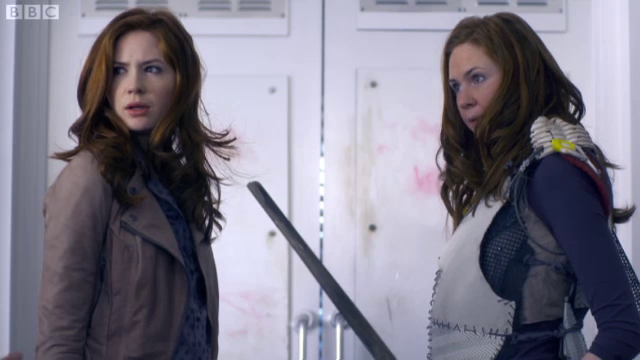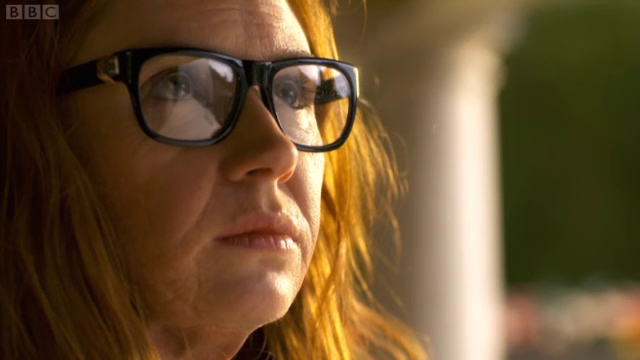Doctor Who Season 6B: The Girl Who Waited
September 19th, 2011
We know it doesn’t matter,
Cause what you came to see
Is what we’d love to give you,
And give it one, two, three!But there may come three, two, one, two
Or jump from nine to five,
And when you see the end in sight
The beginning may arrive!For those who look for meaning,
And form as they do facts,
We might tell you one thing
But we’d only take it backNot back like in a box back
Not back like in a race,
Not back so we can keep it,
Let’s talk about that dread phrase “timey wimey”
“Timey wimey” is a phrase used by a certain particularly annoying type of Doctor Who fan to describe a particular style of story, one that might more accurately be called a Steven Moffat story. That’s because Moffat, starting with his 2007 story Blink, has made Doctor Who into a program about time travel.
Some of you might be thinking “but Doctor Who has *always* been about time travel!”, but it hasn’t, except in the popular imagination, any more than Star Trek was about space travel. In both cases, the ‘travel’ was merely a plot device, to put Our Heroes into situations which are Just Like Earth Except The Roman Empire Never Fell/The Nazis Won (in the case of Star Trek) or to let Our Heroes visit 1066, The Great Fire Of London, The Great Fire Of Rome, And Other Sites You Will Remember From Your History Lessons in the case of Doctor Who.
In fact, I can only think off the top of my head of two Doctor Who TV stories from before 1996 which focus on the time travel as a major element of the plot – Day Of The Daleks and Mawdryn Undead. There may be as many as two or three more in the first hundred and fifty Doctor Who stories, depending on exactly what you count.
This is because, fundamentally, there are only two stories that can be told about time travel – By His Bootstraps and A Sound Of Thunder. Either time can be changed, or it can’t, and either our protagonist wants it to change, or they don’t (or they take advantage of the possibility of time-travel in a fixed-time universe to use stable causal loops that enable them to solve NP-hard problems in polynomial time, create Halting Oracles and otherwise violate the Second Law Of Thermodynamics, giving them Godlike magical powers and allowing them to have complete control over the universe, but that’s not so much a story as my plan for when I figure out how to build a time machine for myself).
Moffat has done stories with both fixed time loops (Blink) and stories where time can be altered (A Christmas Carol), but he tends to try and mix and match the two, using magician-like sleight of hand to cover up (very well) the fact that the resulting story is completely incoherent and illogical (The Big Bang).
The Girl Who Waited is not a Moffat story, but Tom McRae’s script has so many Moffatisms – temporal paradoxes, someone waiting decades for our time-travellers to return, faceless robots, sinister well-intentioned things that just repeat the same innocuous phrase over and over, one of our main cast members dying – that either Moffat almost completely rewrote McRae’s script, or McRae was deliberately impersonating Moffat.
It’s also obviously the cheap episode of the bunch, having only our three main characters (plus a tiny piece of video footage, and a voiceover by Imelda Staunton which presumably took up a big chunk of the budget in itself), and with most of the sets being AppleStore White. In fact, it was tempting to see the beginning of this (the TARDIS and its three-person crew arrives in an all-white area with white robots, having gone off-course) as the second reference this series, after the boxes in the Gaiman episode, to the original series 6. (The Mind Robber, for similar budgetary reasons, had an episode with only the TARDIS crew and a white background. It worked very well).
But cheap or not, this story works, so long as you don’t look at it too closely. It’s a strong central idea, carried off well – Amy has been stranded for thirty years, and the Doctor and Rory can rescue her from her past, but if they do they’ll kill the Amy who lives now.
And for once, in MoffatWho, the plasticity of the past isn’t used as a get-out clause, but in order to ram home quite a devastating finale, when the Doctor has to act like a heartless, calculating bastard and kill someone who is trusting in him in order to save another life. For I think the first time in Moffat’s series – possibly the first time since the series came back in 2005, in fact (though I’ve not seen every post-05 episode) – the Doctor is faced with an actual moral dilemma, makes the right choice rather than the nice one, and isn’t allowed to pull a ‘with one bound, everyone was free’. He has to make a utilitarian calculation, and accept its results, and thus this story goes a long way to rectifying the moral and consequential deficits I’ve pointed out in the past.
Of course, the fact that it does this while all but waving a flag saying “look, knowing the future means you can change it, which means the Doctor’s death can be avoided!” undoes some of this, but not enough to make the story not work – especially when Karen Gillan gives such a good performance (aided by one of the best aging makeup jobs I’ve ever seen) as the two Amys. The show doesn’t usually call on her to do much in the way of acting, but this episode proves that she’s actually extremely good.
Where the program is let down, almost fatally, is the way there needs to be a physical menace, a ‘monster’ to fight (in this case the white robots). This necessity distorts the entire rest of the story, because it means that Amy has had to spend thirty-six years fighting off a robot attack at a rate of what looks like one every two minutes. Even though she’s shown an affinity for combat before, and she’s got a hideout where the robots couldn’t get her, this seems unlikely – she has to be lucky every time, the robots only had to be lucky once.
More to the point, Amy has never shown the slightest technical aptitude in any previous story, yet here she has managed to become a 1337 h4X0r who can reprogram the robots and the central computer, as well as having the technical knowledge to build her own magic wand sonic screwdriver out of spare parts. If she can do this, there are any number of technological solutions to her problem that seem to jump out.
It distorts the whole shape of the story, which wants to be about the central choice of who lives and who dies, and Rory’s relationship with Amy, and what it would mean to wait thirty-six years for someone to rescue you, only for that rescue to mean your death, and perhaps about what it feels like for a middle-aged woman to have her husband dump her for someone in her early twenties who looks just like she used to.
But these themes are not given the time they deserve, because we have to have the iRobots so we can have some action scenes. There’s nothing wrong with Doctor Who being full of robots and monsters and aliens – that’s a big part of the show’s appeal, of course – but whenever they try to do something more interesting, like this, they get in the way. We’re often told that one of the best things about Doctor Who‘s format is that it has no restrictions, that it can go anywhere in time or space and tell any kind of story. Perhaps the creators could try telling a story which doesn’t have a monster in it, just to see if that can do without that restriction?
Either way, in a series that has so far bounced roughly between mediocre and tolerable, with occasional ventures into poor, this episode makes it all the way up to good-but-flawed. And after the ‘quite good, on balance’ of Gattis’ episode the week before, suggests that the series may at last be on an upward trend again.






Leave a Reply
You must be logged in to post a comment.